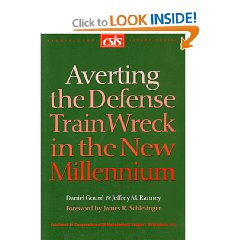It merits emphasis that the author's first conclusion, spanning a diversity of case studies, is that technology may be a catalyst but it rarely drives a revolution in military affairs–concepts are revolutionary, it is ideas that break out of the box.
Their second conclusion is both counter-intuitive (but based on case studies) and in perfect alignment with Peter Drucker's conclusions on successful entrepreneurship: the best revolutions are incremental (evolutionary) and based on solutions to actual opponents and actual conditions, rather than hypothetical and delusional scenarios of what we think the future will bring us. In this the authors mesh well with Andrew Gordon's masterpiece on the rules of the game and Jutland: we may be best drawing down on our investments in peacetime, emphasizing the education of our future warfighters, and then be prepared for massive rapid agile investments in scaling up experimental initiatives as they prove successful in actual battle.
The book is noteworthy for its assault on fictional scenarios and its emphasis on realism in planning–especially valuable is the authors' staunch insistence that only honesty, open discussion among all ranks, and the wide dissemination of lessons learned, will lead to improvements.
Finally, the authors are in whole-hearted agreement with Colin Gray, author of Modern Strategy, in stating out-right that revolutions in military affairs are not a substitute for strategy as so often assumed by utopian planners, but merely an operational or tactical means.
This is a brilliant, carefully documented work that should scare the daylights out of every taxpayer–it is nothing short of an indictment of our entire current approach to military spending and organization. As the author's quaintly note in their understated way, in the last paragraph of the book, “the present trend is far from promising, as the American government and armed forces procure enormous arsenals only distantly related to specific strategic needs and operational and tactical employment concepts, while continu[ing], in the immortal words of Kiffin Rockwell, a pilot in the legendary First World War Lafayette Escadrille, to ‘fly along, blissfully ignorant, hoping for the best.'”
Review: Defense Policy Choices for the Bush Administration 2001 – 2005
4 Star, Empire, Sorrows, Hubris, Blowback, Executive (Partisan Failure, Reform), Intelligence (Government/Secret), Military & Pentagon PowerAmong the recommendations in this book that make it essential reading for anyone concerned with streamlining and revitalizing national security, I consider the following to be sensible:
1) cost savings should not be achieved through the wholesale abandonment of overseas commitments (13);
2) achieve additional cost savings as well as increased operational utility by sharply limiting spending on the most advanced weapons and mobility systems, applying the savings to maintaining readiness and buying larger numbers of “good enough” weaponry (83);
3) citing Stephen Rosen-he could also have cited Colin Gray-he urges a slowdown in the so-called Revolution in Military Affairs (RMA) while emphasizing that true RMA's are less about technology and more about the very best mix of people, time, and information to produce innovation (88);
4) in this vein, he noted the continued excessive focus on mobility platforms rather than C4I or joint service experimentation (90);
5) homeland defense needs several billion more dollars per year (129), a recapitalization of the U.S. Coast Guard by with at least a $750 million a year increase (135), and a sharply increased focus on setting C4I security standards for unclassified communications and computing networks across the nation, with roughly $100 million a year additional;
6) politely put, National Missile Defense is best conceptualized as theater missile defense (TMD, 143); and
7) Taiwan would be a nightmare for all sides.
Among the assertions in this book that give me pause are
1) defense down-sizing in the past ten years has been successful, trimming a third of the budget and manpower while retaining quality and cohesion (p. 1);
2) that 3% of the Gross Domestic Product is adequate for defense spending and we do not need to go to the less-than-traditional 4% (3-4);
3) that the Marine Corps should be employed to relieve Army troops in the Balkans (57) or Korea (80);
4) that North Korean armored forces would have great difficulty breaking through Allied lines to Seoul (71);
5) that rogue nations like North Korea would attempt to provide their infantry with chemical protective gear when using chemical weapons (73);
6) that US airpower is both a rapid-response solution for distant threats as well as an overwhelming response for sustained threats (76, passim);
7) that arsenal ships are survivable in off-shore loiter mode (111); and
8) that an overseas deployment rate of 8% of the total force is too high (227).
Having said that, and with all my reservations about a book, no matter how talented the author, that does not preface its discussion of force structure with a review of the recommended strategy, and a discussion of the recommended strategy with a review of the real-world right-now threat, I have to rate this book a solid four in terms of seriousness of purpose and utility of content.
It would be twice as valuable if it included a thorough discussion of what kind of Global Coverage intelligence investment is needed in order to make defense forces relevant and capable in the future; and if it included a discussion of how defense forces are but the most expensive instrument of national power, and must be designed and funded in consonance with the other instruments, and especially the severely underfunded diplomatic, economic, and cultural instruments.
The author, easily one of the top three citizen-reviewers of the national security spending program, ultimately recommends less expensive weaponry, a different two-war capability (“1+A+i”), selective reductions in overseas deployments, more defense and less nuclear offense, selective increases in homeland defense including the U.S. Coast Guard and joint experimentation, and a modest increase (roughly $25 billion) of the defense budget that would combine with his recommended savings to yield the $60 billion or so transformation delta that others have recommended.
I like and recommend this book. Out of context, however, it is a dangerous book, for it will lead an inexperienced President and a Cold War team to the conclusion that only a transformation of the traditional military (Program 50) is necessary. O'Hanlon has done it again-he has provided the baseline from within which a reasonable public debate about defense transformation might ensue. The military issues he addresses comprise both the foundation and one of the four corners of our future national security-my concern about this book is that it is completely isolated and makes no mention of the other three corners without which we cannot maintain a proper roof over our heads: intelligence (threat understanding), strategy, and Program 150 soft power-power that today is both silent and emaciated.

Review: Killing Pablo–The Hunt for the World’s Greatest Outlaw
5 Star, Empire, Sorrows, Hubris, Blowback, Intelligence (Government/Secret), Military & Pentagon Power, Secrecy & Politics of Secrecy, War & Face of Battle
Mark Bowden
5.0 out of 5 stars Reveals US Sources & Methods, Weaknesses
July 25, 2001
Robert D. Steele (Oakton, VA United States) – See all my reviews
I remember being shocked when a book published by a former prisoner of war revealed all of the CIA's sources and methods for secret writing–one reason terrorists and others make photo-copies of incoming and outgoing correspondence these days….
This book provides an excellent overview of sensitive sources and methods used by the U.S. military to intercept and locate electronic transmissions. It specifically “blows” a cover company, two specific kinds of aircraft, and several U.S. Special Operations Forces standard operating procedures. I suspect that NSA and the CIA Centers dealing with terrorism and with crime and narcotics are having the same difficulties recovering from this book that NSA had when President Reagan inadvertently revealed in public that he was receiving transcripts of Politburo cell phone conversations made while in transit, from their car phones.
Having said that, I find that the author has performed very responsibly as an investigative journalist, and that his story is superior in every respect. I even find that he has withheld some key information out of respect for his sources,and that there are many lessons to be learned from this book about how we might improve our transnational campaign against non-state forces that have vastly more money, ruthlessness, and sheer people power than we do.
I like and recommend this book–it is a real-world story, well-researched and well-told.

Review: Resource Wars–The New Landscape of Global Conflict
5 Star, Congress (Failure, Reform), Empire, Sorrows, Hubris, Blowback, Executive (Partisan Failure, Reform), Military & Pentagon Power, Politics, War & Face of Battle, Water, Energy, Oil, ScarcityThis is a very thoughtful and well-documented book that has been 20 years in the making–although it was actually researched and written in the past three years, the author is on record as having discussed water wars in 1980, and should be credited with anticipating the relationship between natural resources, ethnic conflict, and great power discomfort well before the pack.
He covers oil in particular, energy in more general terms (to my disappointment, not breaking natural gas out from oil, a very relevant distinction for commodities brokers), water, minerals, and timber. His footnotes are quite satisfactory and strike a very fine balance–unusually good–between policy, military, and academic or industry sources.
Sadly, I believe that this book, as with Laurie Garrett's book on the collapse of public health, will be ignored by the …Administration, which appears to have decided that real war is only between states, that energy is something to be increased, not moderated in use, and that real men do not concern themselves with ethnic conflict, small wars, or scarcity of any sort in the Third World.
As I reflect on this book, and its deep discussion of the details of existing and potential resources wars (it includes a very fine illustrative appendix of oil and natural gas conflicts, all current), I contemplate both my disappointment that the author and publisher did not choose to do more with geospatial visualization–a fold out map of the world with all the points plotted in color would have been an extraordinary value–and the immediate potential value of adding the knowledge represented by this book on resources and the Garrett book on public health threats–to the World Conflict & Human Rights Map 2000 published by PIOOM at Leiden University in The Netherlands.
What I really like about this book is its relevance, its authority, its utility. What I find frustrating about this book is that it is, like all books, an isolated fragment of knowledge that cannot easily be integrated and visualized. How helpful it would be, if US voters could see a geographic depiction of the world showing all that the author of this excellent work is trying to communicate, and on the same geographic depiction, see the military dollars versus the economic assistance dollars that the U.S. is or is not investing. The results would be shocking and could lead to political action as the community level, for what is clear to me from this book is that there is a huge disconnect between the real threat, our national security policies, and how we actually spend our foreign affairs, defense, and trade dollars from the taxpayers' pockets.
A trillion dollar tax cut, or a trillion dollar investment in deterrence through investments in natural resource stabilization and extension? Which would be of more lasting value to the seventh generation of our children? The author does not comment–one is left to read between the lines.

Review: While America Sleeps–Self-Delusion, Military Weakness, and the Threat to Peace Today
5 Star, Force Structure (Military), Military & Pentagon Power, Misinformation & Propaganda, Politics, Terrorism & Jihad, Threats (Emerging & Perennial)Especially gripping for anyone who anticipates a future in which Dick Cheney and Colin Powell have something to say about our national security, is the authors' analysis of their strategic decisions following the Cold War. Both Cheney and Powell get very high marks for understanding that global strength is a pre-requisite for stability and security. The Powell vision for a Base Force with Atlantic, Pacific, Strategic, and Contingency force elements is categorized as brilliant. Powell does, however, get very low marks for being consistently unwilling to use force to impose order in the absence of clear objectives-the authors are very clear in calling the Weinberger Doctrine (setting conditions under which force may be used) completely out of date and at odds with today's needs. Both President Bush and Chairman Powell are severely castigated for having ended the Gulf War too soon and without a decisive result-the author's compare this to the similarly indecisive outcome of World War I, an outcome that left the aggressors strong enough to come back and fight another day.
The authors then go on to systematically review a series of major foreign policy and defense failures in the Clinton administration, an Administration characterized by a consistent failure to understand and address the mismatch between wandering and vacillating foreign policies and attendant commitments, and the real-world capabilities of a declining military force. Especially dangerous, in the authors' view, was the Bottom Up Review approach that abandoned the Cheney-Powell appreciation for maintaining sufficient force to deter two regional surprise attacks (Russia and Iraq on one side, China and North Korea on the other), and instead adopted the premise that 6 months warning would be available, that reconstitution of both the force and its industrial base was possible, and that forces could be justified only in terms of existing threats, most of them from non-state actors. Bosnia, Somalia, Haiti, Iraq inspections, North Korea inspections, these are all reviewed and all are found to have left America with a legacy of half measures. “By trying to ignore the problem, to leave it to others, whether the UN or NATO, by declaring it to be of no vital interest to the United States, by refusing to use any force once involved and then to use adequate force once committed, they [Bush Sr. and Clinton] found themselves making the very mistakes that brought defeat and disaster in Vietnam, the fear of which had played so great a role, first in their failure to act and then in their inadequate response.”
In their conclusion, the authors find that the next Administration will assume responsibility at a time when the rest of the world has learned, from the past eight years, that America is not willing to summon the forces to defeat aggression; that developing weapons of mass destruction is the fastest means to elicit billion dollar bribes from America; that ethnic cleansing and politically driven mass starvation will not inspire intervention by America. “The most likely American response will be neglect, at first, followed by some attempt at negotiation. If, at last, driven to action, the Americans attack, it will be from the air, employing limited rules of engagement, and it will not destroy the aggressor. Ground forces will almost certainly not be used until the aggressor himself invites them in as part of a negotiation that gives him [the aggressor] most of what he wants. Above all, he should be sure to develop weapons of mass destruction. Even the hint of such a program in a threatening country will bring high-level American officials on top-secret missions to bribe its leaders to abandon the program. They will probably be able to keep the bribe and to pursue the programs they like, as well. These are the lessons America has given the world in the past eight years…”
The book closes by concluding that the strategic pause is gone and it is almost too late. Forces have declined severely (one can only lament the ill-considered Navy program for decommissioning destroyers and frigates that, once decommissioned, are almost impossible to resurrect), coalitions and alliances are in disarray, and non-state actors have learned how to play on the naiveté of the U.S. Government. America's responsibilities for global stability and security are “inescapable”, and the next President must make the necessary commitments and be materially and morally ready to meet them.

Review: Averting the Defense Train Wreck in the New Millennium (CSIS Report)
4 Star, Budget Process & Politics, Force Structure (Military), Military & Pentagon PowerWhere the book does not go, and a companion book by the same authors would be of great value, is into the detail of
WHAT threat,
WHAT force structure.
They accept, for example, the Navy's 304-ship Navy that keeps adding gigantic carriers and does nothing for littoral warfare or putting Marines within 24 hours of any country instead of 6 days.
Similarly, they accept Air Force emphasis on fewer and fewer bigger and more sophisticated platforms of dubious utility in a 21st Century environment that requires long loiter, ranges of several hundred nautical miles without refueling, full lift in hot humid weather, and survivability in the face of electromagnetic weapons in the hands of thugs.
This book demonstrates a clear mastery of defense economics, and it is an important contribution to the bottom line: our national defense is desperately underfunded, and this must be in the “top three” issues facing the 43rd President and the 107th Congress.
What we buy, and why, has not yet been answered to my satisfaction.







